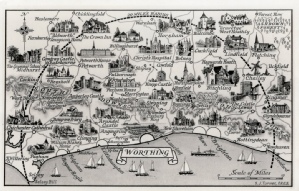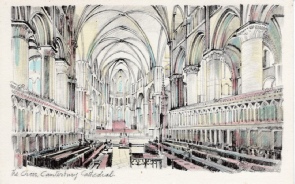
It is thought that Albert Shoesmith stepped down from
the day-
1927, although he remained a director. He then moved
with his family to 133 Stonefield Road, renaming the
house "Rosina" after his wife. The 1937 Electoral
Register records that Florence Shoesmith was living at
this address with her parents. Albert and Rosina moved again in 1940 to 65 Downs Road.
With his partner playing a decreasing role, George Etheridge felt free to begin reshaping their joint business while retaining its original name, and it is thought that on 17th April 1937, George Etheridge purchased the company Shoesmith & Etheridge for £6,350. He held the majority of the shares in the company (5,000), with Shoesmith (750), Muriel Etheridge (300), Alfred Etheridge (300), and Thomas French (100) being the other shareholders. Thanks to his efforts, sales of the cards seem to have greatly increased during the 1930’s. Directories of the period list the firm as wholesale stationers, which may account for the improved card sales.
During the 1930’s Etheridge sought to modernise the cards, and in some cases he cut corners. For example, an early Shoesmith view of the Wish Tower at Eastbourne shows a wall of bathing machines along the shore, as well as many holidaymakers. Etheridge's 1930’s version of the card was printed using the same picture but only after it had been flagrantly doctored. All the bathing machines were removed and no people were left at the water's edge.
Another Shoesmith and Etheridge fake (spotted by Geoffrey Godden, Collecting picture postcards, 1996, Phillimore, Chichester) purports to show the "Pier Music Pavilion by night, Worthing". The pavilion roof is garlanded with little lights, the windows are illuminated and the sea is bathed in moonlight, but the card is in fact a heavily doctored daytime view. The daytime shadows have mostly been skilfully removed, but the forger has left a few in, presumably by mistake! Nowadays the fake would be easy to create in Photoshop, but back in the 1930’s it must have taken hours of toil.
Shoesmith and Etheridge collaborated with Wardell in producing fake nightime views of Brighton, based on daytime prototypes. Although moonlight and electric lighting supposedly provide the only illumination, the cards are quite strongly coloured and nobody seems aware that darkness is supposed to have fallen! Some of the cards are marked "Copyright Wardell's" on the front, others "S & E Hastings" on the back, but the same faker evidently produced both sets of cards. The captions are neatly handwritten in capitals in a very similar size on all the cards.
During the 1930’s, map cards were issued for
some of the main South Coast resorts
(Hastings, Worthing, etc.) depicting places
within a 20 miles radius.
Etheridge also experimented with "Pencil Sketch
Postcards", for example of Bosham, some of
which were coloured.
By May 1934 Shoesmith & Etheridge real photographic cards acquired a distinctive trademark comprising the helmeted head of a Norman knight, with the word "Norman" added in a scroll underneath. As many as nine variants are known.
Several have the words "This is a real photo" dividing the back, while one has "This is a real photograph" as the divider. Others have no divider or simply a vertical line. Postmarks indicate that all nine varieties were first issued in 1934.
By May 1937, the words "S. & E. Hastings" were added below the helmeted head and scroll, and on some cards the words "Real Photograph" took the place of a dividing line. By August 1939 the words "Real Photo British Production" were used as a divider in place of "This is a real photo". July 1939 saw the words "Printed in England" used as a divider.
During 1939 the helmeted badge was discontinued on some cards in favour of a circular badge with "Norman" forming the top half of the circle and "S & E Hastings" the lower half. The words "De Luxe" occupy the centre. Several of these cards have italicised captions. In the late 1930’s a number of other designs were briefly introduced and then quickly dropped.
Numerous buildings within Hastings and St Leonards were used by Shoesmith & Etheridge at one time or another. Included were:
Buss Buildings, 4 Earl Street (originally used to stable horses to pull buses to Ore)
Calvert Road (as above)
153 -
Stonefield Road (showroom)
Tower Road West (housed a guillotine where sheets measuring 3’ * 3’ of Postcards were cut before being sent to the various store rooms before being taken by van to the retailers)
Nelson Road (store)



Shoesmith & Etheridge
S&E Page 5 of 12